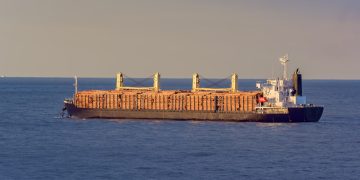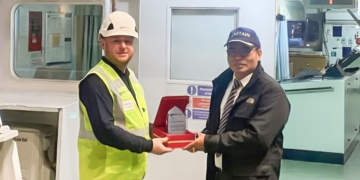–
I want to give you a little different perspective practical I’ll say.
Once upon a time when a post state control was boarding a vessel will make your life the ship manager or the crew miserable and on top of that the flag will come on board to check rectification and make your life more miserable.
Today still the post state control will come on board your vessel and possibly make your life miserable but this is not the case with the flag state.
What we have tried to do as Liberian-flag administration is to take a proactive approach and in partnership always in partnership with a ship managing company and the safety department and the DPA to give you a different perspective and a different proactive approach.
Where we draw our data is from our fleet, today we have 3900 vessel all types tankers, bulk carriers, containers and they assist us in what we call detention – prevention program.
That has only one goal, to prevent any time consuming and also any damaging of reputation, if your vessel is detained. As you know today transparency equasis all over once your vessel is detained everybody knows about.
But in order to be successful in assisting you, you have to assist us. So it’s a cooperative effort between the flag state administration and the ISM department of the ship managing company and in particular of the DPA. In all forms of cooperation, let’s say a vessel calls in any MOU Paris- Tokyo- US Coast Guard we need to receive the pre-arrival notice in our office. We review of course the DPA or the ISM personnel sent to us we review and we do our part which is a risk assessment of what is the probability the port state control will board the vessel and detain.
If we do see that there is a high probability we ask again that DPA or the ISM Department to provide us some data and then we are proposing the best cost of action in order to resolve the situation and assist the vessel.
The advance notice of arrival in certain parts of the world are mandatory like in United States and Coast Guard in certain ports also for certain vessel Paris MoU and China. So once we receive these then we thorough review, if we see a problem then we come up with a number of suggestions in order to resolve the problem and prevent delay of the vessel and possible detention.
We have to use technology, comes into play. LRIT is one nice piece of information where every 12 hours we receive the spot position of the vessel and we have split the entire world in areas so to speak high-risk area from a port state-controlled detention perspective. The United States certain part in China, Australia and certain part in Paris MoU.
When any vessel of those 3.900 in Liberia cross any of these LRIT Zones we receive a message in our head quarters and then just to show you how the LRIT Zones play United States, China, Australia and air Australia very strict on port state control and then Paris MoU and just to get an idea of what we are talking about 3,900 vessels this is it this is one particular day so we have a photo of all the Liberian-flag vessels where they are at any given time
When they cross this LRIT Zone area and we receive a signal then we start doing our work and our work is based on a simple risk assessment and this simple model it has to use two type of criteria the objective criteria and what are the objective criteria is the vessel type container bulk carrier, is the age of the vessel (how old is), is the recognized organization (they recognize organization), is the one that is performed the ISM the MLC audits on behalf of the Flag administration all Flag Administration as in our case and the class society and those are objective now subjective is our criteria. Our criteria is look at the vessel we look at the deficiencies during the last safety inspection and the Liberia maritime law every Liberian-flagged vessel has to go mandatorily once a year safety inspection. We see this safety inspection is overdue we check the record of the class society of the vessel, any previous port state control history (detainable history deficiencies) and then we also check the ISM company (we check the general history of the company, the ship manager, the total fleet, number of vessel detained the last three years and all of that) and then we combine the objective and the subjective criteria and through a risk analysis simplified model we come up with a probability for any given vessel sailing to any given port to be boarded by the port state control. We do all of that you don’t know we do all of that, but we do. This is free of charge we don’t charge nothing for that but once we do this and we come up with a probability the probability is low nothing happened but if the probability is high then we come back to you and we ask for specific information. If you want to see just what kind of results we get from our risk analysis model is for every vessel IMO number, the notice of arrival, the zone that is going (lets say Coast Guard, AMSA in Australia) when we receive the data when the vessel arrives in port and then if there is any recommended action from us (for instance could be we may request for an annual safety inspection or we may request a safety special inspection or we may request for pre-arrival check list) and I’ll tell you in a while what is a pre-arrival check list that we review and we may end up giving you a simple dispensation a simple piece of paper that will justify the potentially detainable item to the port state control. So we get all of that data, this is just an exert.
A vessel is considered high-risk and is going to a port that the probability to be inspected and detained is high then there is a number of actions that we can take again with the cooperation and assistance of the DPA.
You need to think in today shipping partner is the magic word and I think in the earlier session Mrs. Malen mentioned something similar.
A number of actions could be an early annual safety inspection a special safety inspection could be a detail pre-arrival check list, some corrective action dispensation and then if the problem is very serious we as the flag administration we contact the port state control ourselves and we tell them that under our responsibility this vessel has a serious problem so we are taking care of this. All of that is in the right direction because at the end of the day we try to make the life of crew and you easier.
What is this modify when let’s say vessel has a high risk to be aborted after our analyses we send to the DPA a modified pre-arrival check list. This is actually a guide based on our experience and our historical data. It’s a dynamic document that is renewed every year.
We look at all detains and all deficiencies of all Liberian flag vessels worldwide and we have come up with a list of items that if on care on board the vessel , is a hundred 100% detained. If you tell us these before the port state control enter or before the vessel goes into port 90% percent of the times with a dispensation a piece of paper we can justify the vessel.
I have brought samples of these if anyone needs them. You don’t need to have Liberian flag vessels, you can use this on any flag this is port state control data.
So this in a nutshell is the simplicity of a prevention detention program and if you review the last year data it some amazing numbers we receive over 18,000 advance notice of arrivals and zone notification from LRIT. We went through this checklist and check everyone of them and in most of the case if one single item, a malfunction or a deficiency identified within we can issue dispensation. If it is many items that need attendance we can put an inspector of Liberian auditor on board the vessel concurrently or before the port state control inspector goes on board and and in reality what save a possible detention because we are there attending until the problems are rectified.
At the end of the day this is a win-win situation the ship managing company saving face, avoiding a potential port state control detention and also us as a flag that we are responsible to these 3,900 owners and vessels to be top quality white flag we’ll also attain our goal.
This is the international shipping every year they put up a table of performance of all flags and in reality the more green you have the better you are, if you have red means there is some problematic area with a flag but this is just industry shipping indicators to compare one flag to the other.
Above article is an edited version of Michael Pantazopoulos presentation during 2014 SAFETY4SEA Forum
More details may be found by viewing his Presentation video
































































